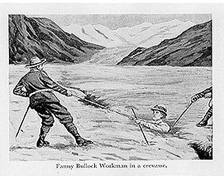This website presents a collection of travel writings by more than 25 female travelers who wrote between 1830 and 1930. All authors came from middle- or upper-class backgrounds and traveled in a variety of capacities, including as botanists, ethnologists, artists, political activists, and wives of diplomats. Their narratives provide fascinating impressions of daily life, religious customs, and political realities of various locales.
The site emphasizes authors who traveled from or to the United States, but includes some texts by European, Middle Eastern, and Australian writers. The writings are included because they discuss places of current interest in the United States. Ten authors write about Africa, eight describe Latin America, a few texts discuss East Asia, two focus on Canada, and one deals with Europe. Two others recount worldwide journeys. Many of the works selected are difficult to access in conventional print format.
The site contains nine images that accompanied the writings of four authors, five enlargeable maps, and five portraits of the authors. Of the 25 authors, 11 are introduced with 400-word biographical sketches. The work of interpreting the texts is obviously more difficult when no biographical information is provided. The site also includes a bibliographic survey of women’s 19th-century travel sources and secondary works on the interpretation of these materials. Nine links are provided to additional websites that contain primary- and secondary-source materials about 19th-century women writers.
One of the site’s most useful features is that the database of texts can be searched by word, by synonym, or by such analytic categories as ethnicity, gender, and occupation. Site creators are also in the process of developing a topic map so users can search the database by such classifications as geographic area, publication type, and theme.
This collection will prove helpful to teachers searching for concrete examples about the nature of cultural contact between people of different backgrounds. Frances Calderon de la Barca, a traveler to Mexico, for example, manages in her first letter to accurately convey some of the complexities of the Aztec cosmological system while simultaneously reducing this complexity to bloody barbarism. Alongside such problematic framing, however, Calderon also records the vivid image of the everyday life of beggars, dignitaries’ carriages, and vocal food vendors who populated Mexico’s streets.
One framework within which many of the texts can be interpreted is the neocolonial era of the late 19th and early 20th centuries and the growing economic and military influence of Europe and the United States in Africa, Asia, and Latin America. Teachers might provide students some context about this historical trend and use these women’s writings as a means of discussing westerners’ views of other peoples, and the reactions provoked by their presence in Africa, Latin America, or Asia. Frances Workman, a suffragist who traveled to Algeria in the late 19th century, for example, perceptively records the subordination of Arabic culture in the context of French imperialism.
Many of the authors were writing during the era of first-wave feminism in Europe and the Americas, so instructors could use these sources to discuss the growth and ramifications of the women’s movement in Western and international contexts. First-wave feminism empowered several of these travelers to undertake the journeys they recount. Teachers might alternately encourage students to examine the concrete limitations on women’s autonomy during this period by discussing such texts as Nellie Bly’s account of her 1890 worldwide journey.


